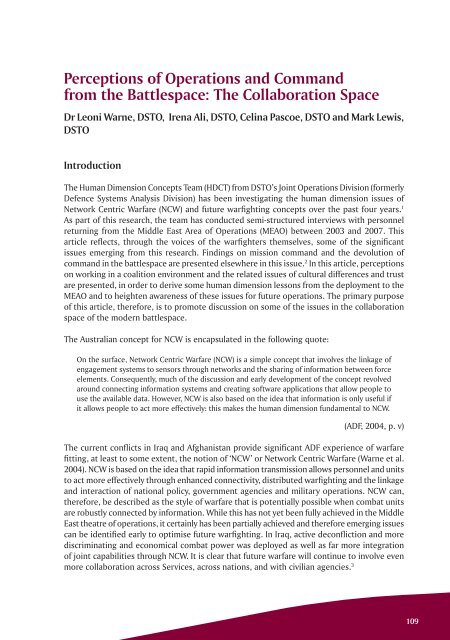ISSUE 176 : Jul/Aug - 2008 - Australian Defence Force Journal
ISSUE 176 : Jul/Aug - 2008 - Australian Defence Force Journal
ISSUE 176 : Jul/Aug - 2008 - Australian Defence Force Journal
You also want an ePaper? Increase the reach of your titles
YUMPU automatically turns print PDFs into web optimized ePapers that Google loves.
Perceptions of Operations and Command<br />
from the Battlespace: The Collaboration Space<br />
Dr Leoni Warne, DSTO, Irena Ali, DSTO, Celina Pascoe, DSTO and Mark Lewis,<br />
DSTO<br />
Introduction<br />
The Human Dimension Concepts Team (HDCT) from DSTO’s Joint Operations Division (formerly<br />
<strong>Defence</strong> Systems Analysis Division) has been investigating the human dimension issues of<br />
Network Centric Warfare (NCW) and future warfighting concepts over the past four years. 1<br />
As part of this research, the team has conducted semi-structured interviews with personnel<br />
returning from the Middle East Area of Operations (MEAO) between 2003 and 2007. This<br />
article reflects, through the voices of the warfighters themselves, some of the significant<br />
issues emerging from this research. Findings on mission command and the devolution of<br />
command in the battlespace are presented elsewhere in this issue. 2 In this article, perceptions<br />
on working in a coalition environment and the related issues of cultural differences and trust<br />
are presented, in order to derive some human dimension lessons from the deployment to the<br />
MEAO and to heighten awareness of these issues for future operations. The primary purpose<br />
of this article, therefore, is to promote discussion on some of the issues in the collaboration<br />
space of the modern battlespace.<br />
The <strong>Australian</strong> concept for NCW is encapsulated in the following quote:<br />
On the surface, Network Centric Warfare (NCW) is a simple concept that involves the linkage of<br />
engagement systems to sensors through networks and the sharing of information between force<br />
elements. Consequently, much of the discussion and early development of the concept revolved<br />
around connecting information systems and creating software applications that allow people to<br />
use the available data. However, NCW is also based on the idea that information is only useful if<br />
it allows people to act more effectively: this makes the human dimension fundamental to NCW.<br />
(ADF, 2004, p. v)<br />
The current conflicts in Iraq and Afghanistan provide significant ADF experience of warfare<br />
fitting, at least to some extent, the notion of ‘NCW’ or Network Centric Warfare (Warne et al.<br />
2004). NCW is based on the idea that rapid information transmission allows personnel and units<br />
to act more effectively through enhanced connectivity, distributed warfighting and the linkage<br />
and interaction of national policy, government agencies and military operations. NCW can,<br />
therefore, be described as the style of warfare that is potentially possible when combat units<br />
are robustly connected by information. While this has not yet been fully achieved in the Middle<br />
East theatre of operations, it certainly has been partially achieved and therefore emerging issues<br />
can be identified early to optimise future warfighting. In Iraq, active deconfliction and more<br />
discriminating and economical combat power was deployed as well as far more integration<br />
of joint capabilities through NCW. It is clear that future warfare will continue to involve even<br />
more collaboration across Services, across nations, and with civilian agencies. 3<br />
109

















